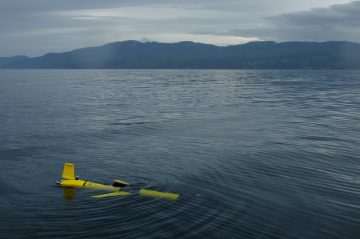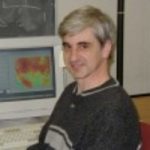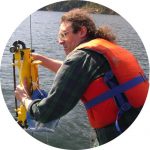
The first step to understanding the world’s oceans is to understand the physical processes guiding them. The ocean’s physical properties and its interactions with the atmosphere, the seafloor and coast are at the heart of the processes that need to be explored as they influence the temperature and density of ocean waters as well as their movements as waves, tides, and currents. The acquired data can then be used to decipher biological processes such as phytoplankton blooms that crucially depend on the aforementioned factors. Additionally, understanding the physical processes that govern ocean processes are key to grasping the global climate and to predict the effects of anthropogenic climate change.
At UBC, physical oceanographers explore the complex factors that shape the oceans (Waterman, Pawlowicz). Several groups focus on the fluid mechanics that govern ocean currents (Allen, Laval, Lawrence, Balmforth) while others focus on specific scenarios such as the mechanics of glaciers (Schoof). The physical interactions of the oceans with the atmosphere are also addressed (Austin, Bertram) as well as biophysics of marine organisms (Martone, Schadwick)

Susan Allen
Professor
Earth, Ocean, and Atmospheric Sciences
Departmental Site and Personal Site
Email
The Allen lab’s background is in fluid mechanics including scaling, analytics, laboratory and numerical modeling with applications in coastal oceanography, mesoscale meteorology and biogeochemical-physical interactions in the ocean. Contributions include advances in the understanding of flow over and around topography, biological-physical interactions and, the study of atmosphere buoyancy driven flows in the mountains.

Phil Austin
Associate Professor
Earth, Ocean, and Atmospheric Sciences
Website and Publications
Email
The Austin lab works on a range of topics that fit under the heading “Cloud Physics”. Much of their research is aimed at better understanding the processes that determine the radiative properties of layer clouds. Austin is especially interested in the ways in which stratus and cirrus clouds form, persist, and dissipate; these clouds exert a controlling influence on the global climate.

Neil Balmforth
Professor
Mathematics
Website and Publications
Email
The Balmforth lab’s research interests are in applied mathematics. Most problems are interesting, and many of them can be couched in a mathematical language that provides insight into them. More specifically, past projects have focused on astrophysics, chaos and dynamical systems, and fluid mechanics with particular application to geophysical fluids.

Allan Bertram
Professor
Chemistry
Website
Email
The Bertram lab focuses on chemical and physical processes important in the atmosphere. Of special interest are atmospheric aerosol particles and the role they play in urban air pollution, climate change and atmospheric chemistry. Ultimately their goal is to better understand the role of human activity on the Earth’s atmosphere.

Bernard Laval
Professor
Civil Engineering
Departmental Site, Personal Site, and Publications
Email
Fluctuations in the quantity and quality of available water, due to climate change and other human influences, greatly affect Canadian life. As part of the Environmental Fluid Mechanics group, Laval focuses on the description and understanding of the physical dynamics of water bodies with the aim of developing numerical models for the prediction of the impacts of climate change and human activities on lake circulation.

Gregory Lawrence
Professor
Civil Engineering
Departmental Site and Publications
Email
Fluctuations in the quantity and quality of available water, due to climate change and other human influences, greatly affect Canadian life. As part of the Environmental Fluid Mechanics groups, Lawrence focuses on the description and understanding of the physical dynamics of water bodies with the aim of developing numerical models for the prediction of the impacts of climate change and human activities on lake circulation.

Patrick Martone
Associate Professor
Botany
Departmental Website, Laboratory Website, and Publications
Email
The intertidal zone of wave-swept rocky shores is one of the most physically stressful habitats on Earth. The Martone lab is interested in intertidal seaweeds, which must survive these conditions wherever they settle and grow. Specific foci of research are the selective pressures driving diversity, convergent evolution, evolution of lignified cell walls, biomaterials and cell wall mechanics, algal physiology and climate change, and costs and benefits of epiphytism.

Richard Pawlowicz
Associate Professor
Earth, Ocean, and Atmospheric Sciences
Website
Email
The Pawlowicz lab is interested in understanding how the oceans work. Heat goes in (and out), fresh water and different chemicals are added (and subtracted), and resulting changes in density create pressure gradients that drive currents – which are in turn modified by the tidal effects of the moon, the spin of the earth, and friction against solid boundaries. Pawlowicz uses a mix of complex fieldwork and careful mathematical analysis to address these questions.

Robert Shadwick
Professor
Zoology
Website and Publications
Email
The Shadwick lab research program focuses on integrative biomechanics addressing the general question of how organisms deal with physical challenges at the level of systems and structures. They study the biomechanics of locomotor systems in fishes, as well as the biomechanical basis of swimming, feeding, breathing, and diving in whales.

Christian Schoof
Associate Professor
Earth, Ocean, and Atmospheric Sciences
Website
Email
Schoof’s work focuses on the flow and dynamic behaviour of large ice sheets and mountain glaciers, motivated in large part by their role in the global climate system. He has a particular interest in abrupt switches or ‘bifurcations’ in the behaviour of ice sheets, which can herald irreversible changes in land ice cover.

Stephanie Waterman
Assistant Professor
Earth, Ocean, and Atmospheric Sciences
Website and Publications
Email
The Waterman lab is interested in process studies related to ocean dynamics. In particular, scale interactions and interrelationships between various components of the oceanic circulation at different time and length scales, governed by different physics are considered. Further, they investigate the implications of these interactions for large-scale circulation and the ocean’s role in the climate system.